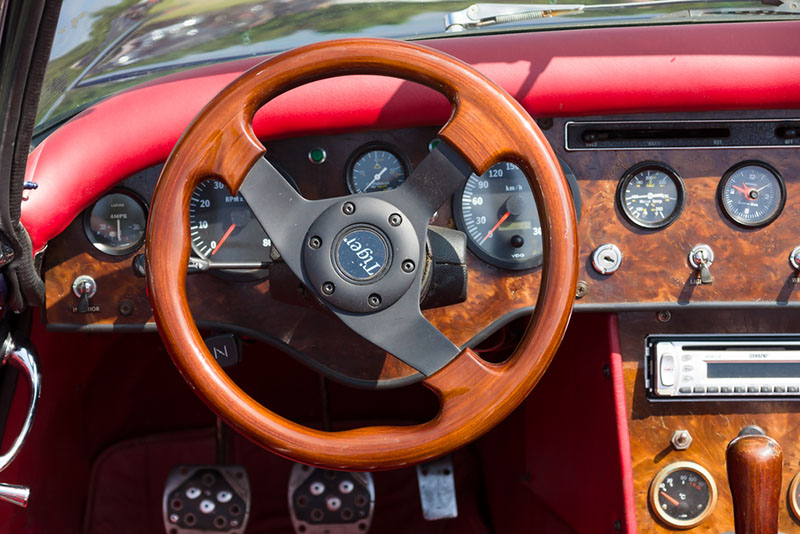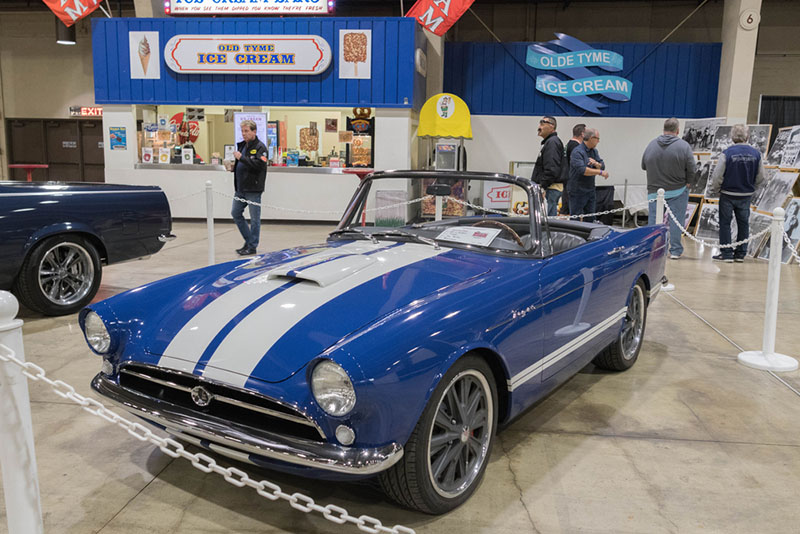Where to Sell my Classic Sunbeam Tiger
The Sunbeam Tiger was manufactured by the Rootes Group.
It was produced from 1964 to 1967
7083 built in total.
It was assembled in West Bromwich, England and was a Sports Car in design
It was a 2-door roadster and was related to the Sunbeam Alpine.
- It had a Tiger I: 260 cu in (4.3 L) V8 (Ford) engine
- A Tiger II: 289 cu in (4.7 L) V8 (Ford).
It had a:
- Ford 4-speed manual transmission
- An 86 in (2,184 mm) wheelbase
- 156 in (3,962 mm) in length
- Width of 60.5 in (1,537 mm)
- Height of 51.5 in (1,308 mm).
The Sunbeam Tiger is a high-performance V8 version of the British Rootes Group’s Sunbeam Alpine roadster
It was designed in part by American car designer and racing driver Carroll Shelby
It was produced from 1964 until 1967.
Shelby had carried out a similar V8 conversion on the AC Cobra
Rootes decided instead to contract the assembly work to Jensen at West Bromwich in England, and pay Shelby a royalty on every car produced.
Two major versions of the Tiger were built:
- Mark I (1964–67) was fitted with the 260 cu in (4.3 L) Ford V8
- Mark II, of which only 633 were built in the final year of Tiger production, was fitted with the larger Ford 289 cu in (4.7 L) engine
Two prototype and extensively modified versions of the Mark I competed in the 1964 24 Hours of Le Mans
Neither completed the race.
Rootes also entered the Tiger in European rallies with some success.
Production ended in 1967 soon after the Rootes Group was taken over by Chrysler

Background
The Sunbeam Tiger was a development of the Sunbeam Alpine series I, introduced by the British manufacturer Rootes in 1959.
Rootes realised that the Alpine needed more power if it was to compete successfully in world markets
The company therefore approached Ferrari to redesign the standard inline-four cylinder engine. They were refused.
Initial prototypes
Ian Garrad despatched his service manager Walter McKenzie to visit the local new car dealerships, looking for a V8 engine that might fit.
The Ford 260 V8 engine appeared to be suitable
It was relatively light at 440 lb (200 kg).
Ian Garrad asked Shelby for an idea of the timescale and cost
Shelby estimated to be eight weeks and $10,000.
Brian Rootes agreed to build a prototype.
Shelby began work on his prototype, the white car as it came to be known, in April 1963
Provisionally known as the Thunderbolt, the Shelby prototype was more polished than the Miles version
It used a Ford 4-speed manual transmission
The Ford V8 was only 3.5 inches longer than the Alpine’s 4-cylinder engine it replaced, so the primary concern was the engine’s width
Shelby found that the Ford V8 would only just fit into the Alpine engine bay
Development
Lord Rootes agreed to have the Shelby prototype shipped over from America in July
He was impressed so that shortly after returning from his test drive he contacted Henry Ford II directly to negotiate a deal for the supply of Ford V8 engines.
Rootes placed an initial order for 3000
Lord Rootes agree that the car would go into production
He decided that it should be launched at the 1964 New York Motor Show
Installing such a large engine in a relatively small vehicle required some modifications
Although twice as powerful as the Alpine, the Tiger is only about twenty per cent heavier but the extra weight of the larger engine required some minor suspension modifications.
Shortly before its public unveiling at the New York Motor Show in April 1964 the car was renamed from Thunderbolt to Tiger.
Production
Shelby had hoped to be given the contract to produce the Tiger in America, but Rootes was somewhat uneasy about the closeness of his relationship with Ford.
It was decided to build the car in England.
The company contracted the job to Jensen in West Bromwich.
The first of 14 Jensen-built prototypes were based on the Series IV body shell, which became available at the end of 1963.
Tiger Production
The Tiger went into production in June 1964
Painted and trimmed bodies were supplied by Pressed Steel in Oxfordshire
The engines and gearboxes came directly from Ford in America.
Jensen was soon able to assemble up to 300 Tigers a month,
The first few Tigers assembled had to be fitted with a Borg-Warner 4-speed all-synchromesh manual gearbox
Ford resolved its supply problems and was able to provide an equivalent unit as used in the Ford Mustang.
Several performance modifications were available from dealers.
The original 260 CID engine was considered only mildly tuned at 164 hp (122 kW), and some dealers offered modified versions with up to 245 hp (183 kW) for an additional $250.
Changes to the Mark II Tiger
The changes to the Mark II Tiger were largely cosmetic:
- The speed stripes
- “egg crate” radiator grille.
Production reached 7128 cars over three distinct series.
The factory only ever designated two, the Mark I and Mark II.
The Mark II Tiger, fitted with the larger Ford 289 cu in (4.7 L), was intended exclusively for export to America and was never marketed in the UK.
All Tigers were fitted with:
- A single Ford twin-choke carburettor
- The compression ratio of the larger Mark II engine was increased from the 8.8:1 of the smaller block to 9.3:1.
Other differences between the versions included:
- Upgraded valve springs
- An engine-oil cooler
- An alternator instead of a dynamo
- Larger single dry plate hydraulically operated clutch
- Wider ratio transmission
- Some rear-axle modifications
There were also cosmetic changes:
- Speed stripes instead of chrome strips down the side of the car
- A modified radiator grille
- Removal of the headlamp cowls.
- All Tigers were fitted with the same 4.5 in (110 mm) wide steel disc bolt-on wheels as the Alpine IV,
- Dunlop RS5 4.90 in × 13 in (124 mm × 330 mm) cross-ply tyres.
The lack of space in the Tiger’s engine bay causes a few maintenance problems including:
- The left bank of spark plugs is only accessible through a hole in the bulkhead for instance
- Sealed with a rubber bung
- The oil filter had to be relocated from the lower left on the block to a higher position on the right-hand side, behind the generator
1964 Sunbeam Tiger convertible
The 1964 Sunbeam Tiger was produced between 1964 and 1967
6450 were made.
The engine was:
- 260 cu in (4.3 L) Ford V8
- The Ford V8 as fitted to the Tiger produced 164 bhp (122 kW) @ 4400 rpm,
- This gave the car a 0–60 mph (97 km/h) time of 8.6 seconds
- Top speed of 120 mph (190 km/h).
The Girling-manufactured brakes used:
- 9.85 in (250 mm) discs at the front and 9 in (229 mm) drums at the rear.
The suspension was independent at the front, using coil springs
At the rear had a live axle and semi-elliptic springs.
Apart from the addition of a Panhard rod to better locate the rear axle, and stiffer front springs to cope with the weight of the V8 engine, the Tiger’s suspension and braking systems are identical to that of the standard Alpine.
- The fitting points for the Panhard rod interfered with the upright spare wheel in the boot
- It was repositioned to lie horizontally beneath a false floor
- The battery was moved from beneath the rear seat to the boot at the same time.
- The kerb weight of the car increased from the 2,220 lb (1,010 kg) of the standard Alpine to 2,653 lb (1,203 kg).
1964
All but 56 of the 1649 Mark I Tigers assembled were shipped to North America,
It was priced at $3499.
In an effort to increase its marketability to American buyers the car was fitted with “Powered by Ford 260” badges on each front wing beneath the Tiger logo.
The Mark I was unavailable in the UK until March 1965, when it was priced at £1446.
Mark II
Sunbeam Tiger Mark II
The Sunbeam Tiger Mark II was produced in 1967 with 633 being made. The engine was 289 cu in (4.7 L) Ford V8.
It was priced at $3842
The Mark II Tiger was little more than a re-engined Mark IA
The larger 289 cu in (4.7 L) Ford engine improved the Tiger’s 0–60 mph (97 km/h) time to 7.5 seconds, and increased the top speed to 122 mph (196 km/h).
Officially the Mark II Tiger was only available in the US, where it was called the Tiger II.
Demise
By 1964 the company was in serious financial difficulties.
At the same time, Chrysler was looking to boost its presence in Europe, and so a deal was struck in June 1964 in which Chrysler paid £12.3 million ($34.44 million) for a large stake in Rootes.
In 1967 Minister of Technology Anthony Wedgewood Benn approached BMH and Leyland to see if they would buy out Chrysler and Rootes and keep the company British
It failed.
Later that year Chrysler was allowed to acquire a controlling interest in Rootes for a further investment of £20 million.
The Tiger name was resurrected in 1972 when Chrysler introduced the Avenger Tiger, a limited-edition modified Hillman Avenger intended primarily for rallying.
In popular media
The 1965 Tiger Mark I gained some exposure on American television as the car of choice for Maxwell Smart in the spoof spy series Get Smart.
The Tiger was used for the first two seasons in the opening credits, some of the scenes featured unusual modifications such as a retractable James Bond-style machine gun.
During its early years Rootes advertised the car extensively in Playboy magazine and lent a pink Tiger with matching interior to 1965 Playmate of the Year Jo Collins for a year.
The Tiger also featured in the 2008 film adaptation of the Get Smart TV series.

